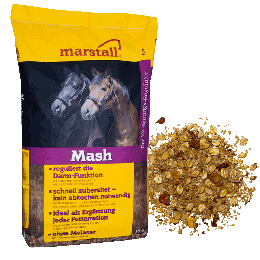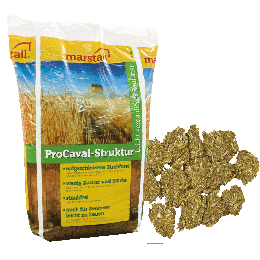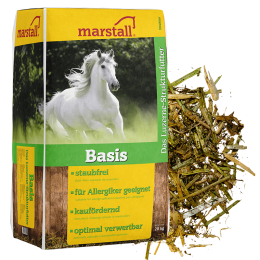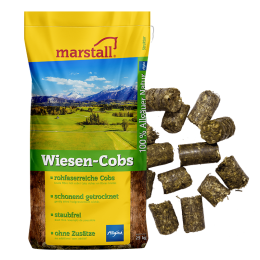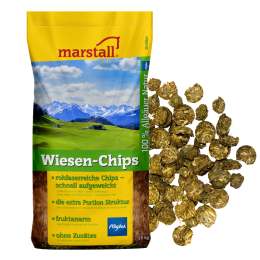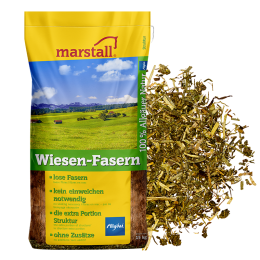What to do when hay is scarce and the quality is inferior?
In some areas, 2019 was not a good year for hay harvesting after 2018. How can horse owners and barn owners compensate? And what should you pay attention to when feeding alternatives such as silage/hay, cobs, chaff or straw? We give an overview.
- Facts harvest 2019
- Roughage quantities - recommendation vs. practice
- Alternatives to hay - this should be considered
- How can you recognise good quality haylage or silage?
- Prices 2019 for hay and straw

Translation: What to do when harvests are scarce?
The situation is partly serious. The second year of drought in a row is pushing not only farms but also horse owners to their economic limits in some areas of Germany. While the horses were still standing on lush green pastures in the south at the end of September, quite a few horse owners in parts of eastern and northern Germany had to stable their horses as early as mid-August. The Bavarian Upper Franconia was also affected again.
Facts harvest 2019
As the rain stopped falling earlier this year than in 2018, it was even drier in some places than last year. As in 2018, some federal states again released ecological priority areas (e.g. areas with catch crop cultivation or green cover) for use in 2019.
Record prices as in the drought year 2018 do not have to be paid for hay and straw this year, but still more than usual. Information on the current prices can be found below.
Roughage quantities - recommendation vs. practice
There is a wide gap between the increasingly difficult weather conditions for horse husbandry and the current feeding recommendations (GfE 2014): at least the energetic maintenance requirement of the horses (e.g. 63 MJ ME for a 600 kg horse) should be covered by hay and other coarse feed. In the case of excess hay with about 6 MJ ME per kg, this would mean about 10 to 11 kg hay/day for a 600 kg horse. In other words: about 1.7 kg hay/100 kg live weight. According to GfE 2014, the absolute minimum for coarse feed in the daily ration is 1.0 kg/100 kg LG and is considered absolutely necessary to maintain the gastrointestinal health of the horses. However, species-appropriate horse management requires significantly higher amounts of roughage.
There are few alternatives to hay in horse feeding. In addition to good feed straw, haylage, silage or hay substitutes from feed manufacturers can be incorporated into the ration.
Alternatives to hay - this should be considered
1. Straw
should not be given more than 1 kg/100 kg body weight daily due to the risk of constipation. The rest you have to cover with hay or other hay substitutes. That would be about 4 kg for a 600 kg horse.
In addition, you should ensure a high water intake and as much exercise as possible with increased straw feeding. Often horses only drink the minimum from the tongue drinker. Here you could also drink lukewarm, clean water from a bucket. Several mash meals per week would also help your horse to keep its digestion going. And another important thing: Only good straw (golden yellow, not dusty, no black stalks, no musty, mouldy smell) is suitable as feed straw!
An alternative to straw is the marstall ProCaval structure. The straw fibre is broken down by extrusion (heat, moisture and pressure) and therefore more easily digestible. The tasty chips can be fed dry or soaked.
Product recommendation
2. Alfalfa
like clover, belongs to the legume family. These plants can bind atmospheric nitrogen with the help of the nodule bacteria of their roots. They are therefore independent of nitrogen fertilization and are inherently richer in protein than grasses.
Alfalfa is usually fed as hay, green meal pellets, cobs or very often as chaff.
What is to be observed with alfalfa:
- Alfalfa hay may only be prepared gently so that the valuable, fine leaf portion is not broken. The quantities used are limited due to the high protein and calcium content. It is (just like the second hay cut) more suitable for lactating mares and foals. When hay is scarce, lucerne hay is an ideal supplement to straw.
- Alfalfa chaff is usually coarse and hard. They contain few leaf parts rich in minerals and protein. Even though their use as a handful of structure underneath the concentrated feed is very useful for promoting purchase, there is still reason for caution. Recent studies have shown the risk of mucous membrane lesions in the stomach mucosa (Vondran et al, 2017) due to feeding alfalfa chaff. Therefore hay chaff or Timothy grass chaff should be preferred. We use Timothee for example in the marstall Müsli 'Naturell'.
marstall Basis consists of softer alfalfa fibre and also contains more leaves. As it is also oiled, it can be added to supplement protein and energy
Product recommendation
3. Haylage/silage
are often better than their reputation and, if necessary, a possible alternative. But only good qualities may be fed and not every horse tolerates fermented roughage. This is because the fermentation of protein-containing feed always produces histamine.
Silage is generally low in raw fibre and richer in protein than hay (fermenting hay) and should therefore only be fed to horses in exceptional cases.
Futterkonserve | Wassergehalt | Trockensubstanz (TS) |
Heu | ca. 15 % | ca. 85 % |
Silage | 60-65 % | 35-40 % |
Heulage (Gärheu) | 25-45 % | 55-75 % |
Hay cannot be replaced 1:1 by haylage/silage. The higher the water content, the more of this feed must be used. If theoretically the hay ration of a 600 kg horse should be completely replaced by haylage, you would have to feed about 12.5 kg of hay instead of the 10 to 11 kg hay. From the silage you would have to feed about 16.5 kg as equivalent.
How can you recognise good quality haylage or silage?
- Visual: There must be no white, black mould or beige yeast stains. These occur, for example, if the bale was not sealed 100 % airtight but has (small) holes in the film.
- Odor: Hay or silage should smell fresh and pleasant. If the bale smells of vinegar or alcohol, the lowering of the pH-value was delayed and this led to microbial colonisation. The quality is strongly reduced. If the bale smells of butyric acid, putrid or even carrion, feeding would be dangerous. The bale must be disposed of!
- At the bale pressing: Good hay is pressed very tightly, leaving as little air space as possible even with coarse-stemmed grass. It is best to wrap the bales twice and with thicker film.
- Where possible, silage additives such as propionate have been used in the production.
It is also important: A bale of hay should be used up within a few days to prevent secondary fermentation or mould formation!

4. Hay substitute products
The manufacturers' range of hay replacement products is wide. Just to name a few examples: There are cobs or chips for soaking from meadow hay, alfalfa or Timothy grass, chopped, loose hay or alfalfa stalk chaff for dry feeding, oiled chaff with or without molasses, products without minerals and vitamins, as well as products with complete mineralisation, broken up straw chips and much more. The hay replacement products on the market differ, for example, in origin, quality (sand content), chop length, preparation form, fructan content, dust, ingredients and additional benefits. You can read more about this here
Such hay replacement products are of course more expensive than loose hay, because they are based on a complex production process (recovery, cleaning, drying, bagging, distribution, etc.). However, with branded products you also get a high quality with assured ingredients. Since hay replacement products are usually only fed as a partial replacement to improve poor hay qualities, the high price is relativized.
The article will show you how to recognise high-quality haymaking products:
Prices 2019 for hay and straw
While in winter 2018 the average price for a big bale was an astronomical 18 € per quintal (180 € per tonne), by September the price had fallen to a national average of only 12.90 €/dt, instead of about 10 to 11 €/dt as in previous years. The highest hay prices in September were paid in Lower Saxony (14.60 to 15 €/dt) and Brandenburg (14.20 €/dt). In Thuringia, however, hay was traded for 8.50 €/dt and in Bavaria the price in September was 11.50 €/dt.
The straw harvest and prices also varied from region to region. In September, the average price in Germany was €8.50/dt (€85 per tonne) per big bale, with strong variations of €13.80/dt in Schleswig-Holstein and only €5/dt in Thuringia or Saxony.
(Source: Agrarheute, status Sept. 2019)

